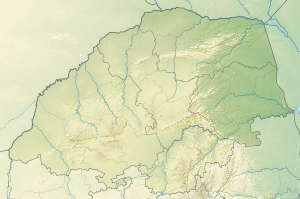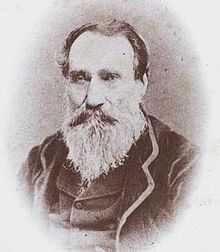Schoemansdal, Limpopo

Schoemansdal (initially Zoutpansbergdorp) was a settlement situated 16km west of Louis Trichardt (Makhado), which had its origins during the Great Trek. It existed from 1848 to 1867, and functioned as the capital of an autonomous region until the S.A.R. Volksraad was established. The settlement was evacuated after only thirty years when attacked by Venda militants. After the S.A.R. reestablished control over the area in 1898, the former settlement was ignored and a new one started, at the present Makhado. Consequently Schoemansdal was the only Voortrekker settlement not to evolve into a modern town.
Early voortrekkers
The earliest western visitors to the area after the renegade Coenraad de Buys, were the Voortrekker parties led by Hans van Rensburg and Louis Tregardt. They arrived separately at the Zoutpansberg in 1836, after parting ways due to an earlier disagreement. Van Rensburg headed east towards Inhambane but his entire party was exterminated en route. Tregardt stayed at the Salt Pan from May to August 1836 and arrived at the site of future Schoemansdal on 3 November 1836. They stayed about two weeks, but resided in the general vicinity for more than a year. After reconnaissance missions into the current Zimbabwe and eastwards into current Mozambique in search of the Van Rensburg clan, they made Delagoa Bay their destination, away from British influence. They started on their epic journey in September 1837 and reached Delagoa Bay seven months later. The trek exacted a high toll; 27 of 53 persons perished from malaria, including Tregardt.
Zoutpansbergdorp
In 1848,[1] eleven years after Tregardt's departure, a settlement named Zoutpansberg(dorp) was established at Tregardt's earlier camp. It was founded by Jan Valentyn Botha[2] who led a faction of Andries Potgieter's trek. Potgieter, who headed the earlier reconnaissance mission over the Limpopo river, arrived from Ohrigstad where his followers were being decimated by malaria. He was of the opinion that the Zoutpansberg was sufficiently distant from British influence to afford the possibility of independence, and chose the location as the capital of his republic.
The settlement had a promising start and a church and fort were built. Portuguese traders opened trading stores and the ivory trade blossomed. Potgieter enjoyed independence in this northern outpost and ruled over extensive territory. He and his followers opposed the notion of a Volksraad for the Overvaal region, besides any relations with Cape colonial authorities.[3]
In 1849 the Voortrekker faction led by J.J. Burger that remained in Ohrigstad (and subsequently Lydenburg) engaged in a series of negotiations with the faction headed by Andries Pretorius in Potchefstroom. After meetings at Hekpoort, Olifants River and Derdepoort respectively, an Overvaal Volksraad was constituted. Potgieter at first refused to accept its authority but relented when faced with an embargo.[3] Potgieter rendered no assistance to the Transoranje voortrekkers when their republic was annexed by Britain in 1848. He died at Zoutpansbergdorp in 1852, months after Andries Pretorius negotiated the independence of the Overvaal with British authorities. He left his son, cmdt.genl. Piet Potgieter, in charge of the town.


In September 1954 Piet's uncle, field cornet Hermanus Potgieter (Groot Hermaans), was searching for ivory near the Nyl River, an area ruled by chiefs Makapan and Mankopane (or 'Mapela'/'Mapele'). For reasons imperfectly known, the chiefs decided to massacre them and other unrelated white travellers. The act claimed the lives of 28 white settlers,[4] and the Potchefstroom governance authorized a punitive commando under the command of Piet Potgieter and M. W. Pretorius. The tribesmen retreated into Makapansgat cave, where they were to suffer heavy casualties. One of their snipers however managed to fatally shoot Piet Potgieter.[5] This was the only Boer casualty of the campaign, but brought an end to the Potgieters' hegemony in the north.
Schoemansdal
The Potgieters' passing was followed by a number of local disputes. In 1855 the town's de facto leader was Stephanus Schoeman[2] who named the growing, though disorderly reed-hut settlement Schoemansdal, after himself. Augmented by renegades, the town was a successful ivory trading centre by 1855, when its population numbered 200. The town became a refuge for increasingly lawless ivory hunters and traders. Arms smuggling was rampant and at one point 30 tons of lead was imported for manufacturing of bullets.[3]
Venda hunters supplied the Voortrekkers with ivory, and were in turn supplied with fire arms. Relations between the Voortrekkers and Venda soured due to taxation, cattle rustling and lax control over fire arms.[2] Total discord broke out in 1866, when the Voortrekkers intervened in a Venda succession dispute, and one claimant, Makhado, attacked and torched an outlying voortrekker settlement.[1] Despite the arrival of a relief commando, the Venda's mountain strongholds could not be taken. The voortrekkers abandoned the town on 15 July 1867[2] and established Pietersburg.
Schoemansdal was never rebuilt and its graveyard is all that remains today.[6] An open-air museum was established to recreate the modest settlement.
See also
References
- ↑ 1.0 1.1 Knight, Ian; Gerry Embleton (1996). The Boer Wars (1): 1836-98. Osprey Publishing. p. 20. ISBN 1-85532-612-4.
- ↑ 2.0 2.1 2.2 2.3 Hopkins, Pat (2006). Ghosts of South Africa. Zebra. pp. 75–76. ISBN 1-77007-303-5.
- ↑ 3.0 3.1 3.2 "Die Eerste Gesamentlike Vergadering van die ZAR se Volksraad in 1849 (The first joint meeting of the ZAR Volksraad in 1849)". toxinews.blogspot.com. Retrieved 4 March 2013.
- ↑ "Site 9/2/257/0001". SAHRA. Retrieved 24 October 2013.
- ↑ "Geskiedenis van Makapansgat". solidariteit.co.za. Retrieved 24 October 2013.
- ↑ Op Pad in Suid-Afrika. B.P.J. Erasmus, 1995, ISBN 1-86842-026-4
Coordinates: 23°03′09″S 29°46′12″E / 23.05250°S 29.77000°E